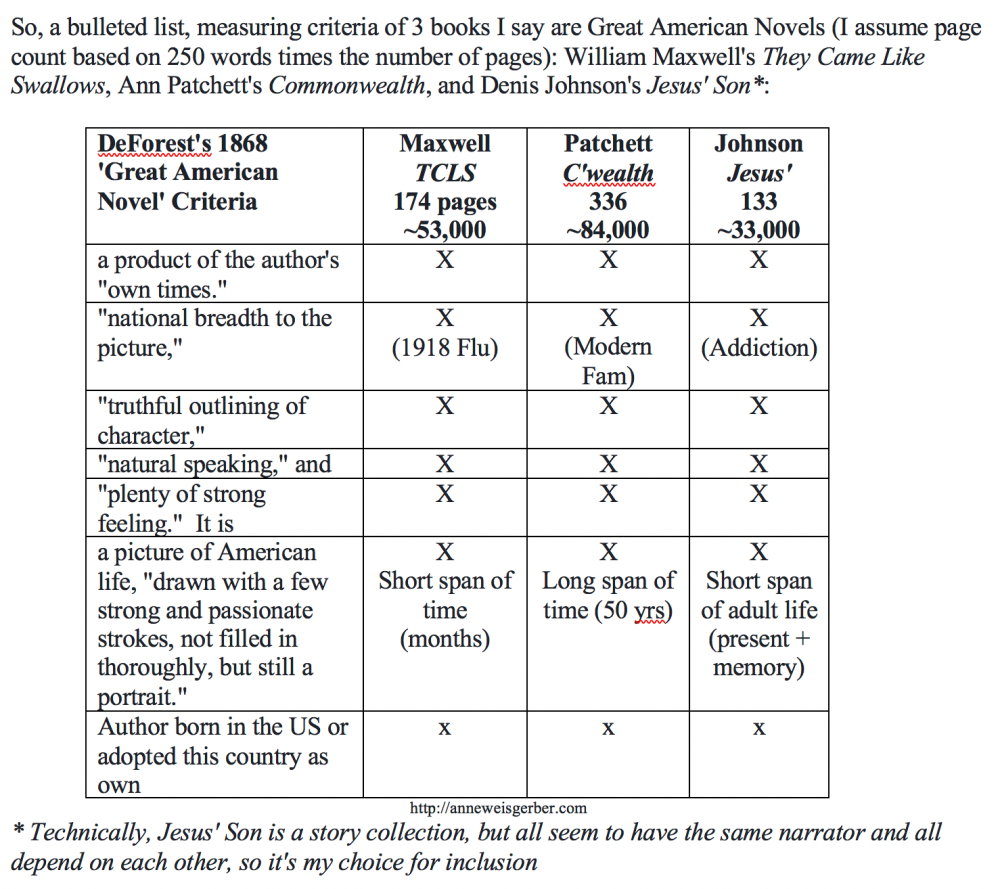by A. E. Weisgerber
Like some of my writing pals, this year I’m buckling down to write my first novel. Is it a cliche, if one is American and decides to write a novel, or is it totally wig-flipping crazy, to intend to write a ‘Great American Novel’? Asking for a friend or two.
The first use of the phrase was recorded on 9 January 1868 — 151 years ago — by John William DeForest in The Nation. In his essay, the GAN is described as a “picture of the ordinary emotions and manners of American existence.” He calls it “the task of painting the American soul” in a novel framework.
DeForest took a look around his post-bellum landscape, and realized Washington Irving (of Rip Van Winkle and Sleepy Hollow fame) failed, because his narratives slipped back to past times; James Fennimore Cooper failed, because he focused on the Indians (“of whom he knew next to nothing”) or backwoodsmen and sailors (“whom he idealized.”); Nathaniel Hawthorne? Failed. His characters, says DeForest, express themselves “in the language of men who never expressed themselves but on paper.” I have the same difficulties with Irving, Cooper, and Hawthorne (as do many of my students) that DeForest articulated so long ago. I trust a guy whose burns are still savage. His notion, that literature needed to make a turn toward realism, or showing life the way things really are, remains valid.
At the time of his essay, the French had Balzac and Sand, and the English had Thackeray and Trollope, yet DeForest made his case the US had nobody. It makes sense, in hindsight. The Gettysburg Address was delivered by Lincoln only five years earlier, in 1863, so the American psyche was very much divided. Huckleberry Finn would not be written until 1883, Gatsby 1925, Faulkner’s Absalom! in 1936, Wright’s Native Son in 1940, Kerouac’s On the Road in 1951, DeLillo’s White Noise and Toni Morrison’s Beloved a century later.
Reading his essay, I like DeForest’s impatience.
I suppose any reviewer of contemporary works of fiction and non-fiction will note a hallmark of contemporary literature is its blending of fiction and non-fiction. The importation of the realism of the camera, the autobiography, and our journalistic filters, into fiction. The internet has certainly revved up the engine. It all might make DeForest’s head spin in marvel and disgust and wonder.
DeForest said the great American novel should be a product of the author’s “own times.” His best praise was for Harriet Beecher Stowe’s Uncle Tom’s Cabin (1850). Although he conceded it has “a very faulty plot,” with a black man “paited whiter than the angels,” he said what worked for UTC, and makes it great, is the “national breadth to the picture, truthful outlining of character, natural speaking, and plenty of strong feeling.” It is a picture of American life, “drawn with a few strong and passionate strokes, not filled in thoroughly, but still a portrait.”
A writer whose work I’m examining lately, Ann Patchett, wrote a few years back about what constitutes for her the Great American Novel. She tops her response with The Great Gatsby, but cautions this may be because “it’s short and appropriate for the classroom.” She then mentions the much longer and worthy Huckleberry Finn and Moby Dick. She says, “If I could nominate a contender, a book that was both brilliantly written and offered up some profound wisdom about the condition of American life, it would be John Updike’s Rabbit at Rest, though Rabbit Is Rich wouldn’t be a bad choice either.” She also mentions Philip Roth’s The Human Stain.
But each of us has their own idea about what exemplifies the Great American Novel. I agree Gatsby is up there. It’s got the story of beautiful, star-crossed losers ensconced in the national Jazz Age landscape (touching upon prohibition, organized crime, and the Lost Generation of World War I). Amazing. It’s a slender 180 pages, only 47,000 words.
I think Patchett’s Commonwealth also suits my fancy as a GAN. I think Denis Johnson’s collection hits its marks, too.
 So, all of my choices, whom in some sense I love as models for my own endeavor, meet DeForest’s criteria.
So, all of my choices, whom in some sense I love as models for my own endeavor, meet DeForest’s criteria.
By the way, I have NEVER read Uncle Tom’s Cabin so I found a copy online and… couldn’t take it; it’s dreadful to my ear (unlike say William Faulkner’s Absalom, Absalom! which fascinated me and I read in a single sitting.)
I also understand that, no matter what one intends at the outset of a writing journey, one can’t control the outcome. Characters are going to evolve in a way that makes sense as they are created.
Ann Patchett says, in her memoir about writing, The Getaway Car, ”You learn things about characters as you write them, so even if you think you know where things are heading, don’t set it in stone; you might change your mind. You have to let the action progress the way it must, not the way you want it to. You create an order for the universe and then you set that universe in motion.”
It’s creating the order of the universe that requires intention. DeForest’s criteria, I think, can help. Well, it’s a warmup stretch, and can’t hurt. Well, this seems to be veering in the direction of another essay.
So, I’m psyching myself to begin. If you were to undertake writing a GAN and still be true to yourself, would you aim to please old man DeForest? I’m thinking his checklist, like some martini mixologists do with the vermouth, advises to have all ingredients at hand, then let the spirit move you.
Thinking about Maxwell, Patchett, and Johnson also makes me realize I can set a goal length of about 56,000 words. If I were to write that much, I’d have to write at least 325 words a day for 6 months. I think I can.
Whew!

If you are undertaking writing your first novel, feel free to follow. I may not write frequently about my process, but it does help to stop and think every now and then. Thanks for stopping by.
Note: Header image is of Eric Zener’s painting, Ride of Your Life. Photographed at Gallery Henoch, 555 W 25th St, NYC; 2/21/2017
Contact